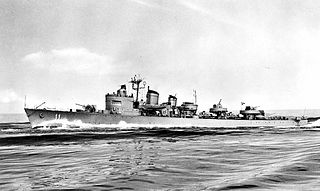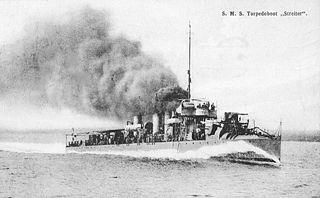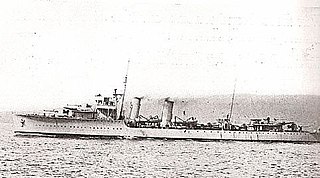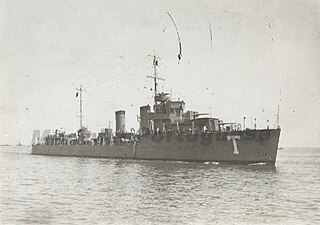Service history
Tejo went into service in 1904, but tests were continued on it until 1906. The initial armament consisted of one 100 mm (3.9 in) gun, one 65 mm (2.6 in) gun, four 47 mm (1.9 in) guns and two torpedo tubes. However, during tests, its broad range of roles limited its effectiveness overall. The decision was then made to transform Tejo completely into a destroyer.
After the First Portuguese Republic was established, the ship was recommissioned as NRP Tejo.
In 1910, Tejo accidentally ran aground in Peniche and suffered severe damage. Five years later, in 1915, the ship was taken to port to be converted completely to a destroyer. These changes were completed in 1917 and the ship became a full-fledged destroyer. It retained most of its armament, only swapping the 65 mm gun for a 76 mm (3.0 in) gun. While undergoing tests, Tejo proved to be the fastest ship of the Portuguese Navy.
Tejo was scrapped in 1927.
This was the second ship in Portugal's history to bear the name Tejo. A gunboat in 1868 was the first and a destroyer of the Vouga class - launched in 1935 - was the third.

In naval terminology, a destroyer is a fast, maneuverable, long-endurance warship intended to escort larger vessels in a fleet, convoy, or carrier battle group and defend them against a wide range of general threats. They were originally conceived in 1885 by Fernando Villaamil for the Spanish Navy as a defense against torpedo boats, and by the time of the Russo-Japanese War in 1904, these "torpedo boat destroyers" (TBDs) were "large, swift, and powerfully armed torpedo boats designed to destroy other torpedo boats". Although the term "destroyer" had been used interchangeably with "TBD" and "torpedo boat destroyer" by navies since 1892, the term "torpedo boat destroyer" had been generally shortened to simply "destroyer" by nearly all navies by the First World War.

A torpedo boat is a relatively small and fast naval ship designed to carry torpedoes into battle. The first designs were steam-powered craft dedicated to ramming enemy ships with explosive spar torpedoes. Later evolutions launched variants of self-propelled Whitehead torpedoes.

HMS Ambuscade was a British Royal Navy destroyer which served in the Second World War. She and her Thornycroft competitor, HMS Amazon, were prototypes designed to exploit advances in construction and machinery since World War I and formed the basis of Royal Navy destroyer evolution up to the Tribal of 1936.

USS Satterlee (DD-190) was a Clemson-class destroyer in the United States Navy, entering service in 1919. After brief service until 1922, the ship was placed in reserve. The ship was reactivated for World War II before being transferred to the Royal Navy in 1940. Renamed HMS Belmont, the destroyer was used as a convoy escort in the Battle of the Atlantic where she was torpedoed and sunk on 31 January 1942.

The Caldwell class was a class of six "flush deck" United States Navy destroyers built during World War I and shortly after. Four served as convoy escorts in the Atlantic; the other two were completed too late for wartime service. Two were scrapped during the 1930s, but four survived to serve throughout World War II, three of these in service with the Royal Navy under the Destroyers for Bases Agreement and the fourth as a high speed transport.

Navarin was a pre-dreadnought battleship built for the Imperial Russian Navy in the late 1880s and early 1890s. The ship was assigned to the Baltic Fleet and spent the early part of her career deployed in the Mediterranean and in the Far East. She participated in the suppression of the Boxer Rebellion in 1900 before returning to the Baltic Fleet in 1901. Several months after the beginning of the Russo-Japanese War in February 1904, she was assigned to the 2nd Pacific Squadron to relieve the Russian forces blockaded in Port Arthur. During the Battle of Tsushima in May 1905, she was sunk by Japanese destroyers which spread twenty-four linked mines across her path during the night. Navarin struck two of these mines and capsized with the loss of most of her crew.
Two Swordfish-class destroyers served with the Royal Navy. Swordfish and Spitfire were both built by Armstrong Whitworth at Elswick, Tyne and Wear launching in 1895. Fitted with Yarrow boilers, they could make 27 knots and were armed with one twelve pounder and two torpedo tubes.

The Churruca class was a Spanish destroyer class built for the Spanish Navy based on a British design. Eighteen ships were built, with two being sold to Argentina and commonly referred to as the Cervantes class. The last two members of the class are sometimes referred to as a separate class, the Alava class.

The Visby class was a Swedish World War II destroyer class. During the years 1942–1944 four ships, Visby, Sundsvall, Hälsingborg and Kalmar, were built and delivered to the Swedish navy. The ships were a part of Sweden's military buildup during the war. Under this period the ships were used as neutral guards and escort ships. In 1965 the ships were modified and rebuilt as frigates. Two of the ships were decommissioned in 1978 and the last two followed in 1982.

Beograd was the lead ship of her class of destroyers, built for the Royal Yugoslav Navy in France during the late 1930s, and designed to be deployed as part of a division led by the flotilla leader Dubrovnik. She entered service in April 1939, was armed with a main battery of four 120 mm (4.7 in) guns in single mounts, and had a top speed of 35 knots.

The Soldato class was a class of destroyers of the Italian Regia Marina built by Ansaldo of Genoa prior to the First World War. Ten were built for the Regia Marina between 1905 and 1910, while an eleventh ship was built for China but purchased by Italy before completion. They served during the First World War, where one was lost, with the remaining ships sold for scrap in the 1920s and early 1930s.

A torpedo cruiser is a type of warship that is armed primarily with torpedoes. The major navies began building torpedo cruisers shortly after the invention of the locomotive Whitehead torpedo in the 1860s. The development of the torpedo gave rise to the Jeune École doctrine, which held that small warships armed with torpedoes could effectively and cheaply defeat much larger battleships. Torpedo cruisers fell out of favor in most of the great power navies in the 1890s, though many other navies continued to acquire them into the early 1900s.

The Huszár class was a class of destroyers built for the Austro-Hungarian Navy before the First World War. They were built to a design by the British shipbuilder Yarrow Shipbuilders, who built the first ship, with a further 11 ships being built in Austrian and Hungarian yards between 1905 and 1909. A replacement ship was built when the lead ship was lost in an accident in 1908, and another ship of similar design building for the Chinese navy was seized on the outbreak of the First World War. Two ships were lost during the war, a single ship serving with the Greek Navy following the end of the war, and the remainder being scrapped.

The Antioquia class of destroyers consisted of two ships, ARC Antioquia and ARC Caldas, used by the navy of Colombia, the Armada Nacional República de Colombia, between 1934 and 1961. Initially constructed at the Lisbon Naval Arsenal as part of the Portuguese Navy's Douro class, they were acquired by Colombia before completion in response to the Peruvian purchase of two destroyers during the war with Peru. They arrived too late to see service in the conflict and saw little action during their service lives. They underwent a major refit in the mid-1950s which saw their armament completely redone. Following their removal from service in 1961, they were broken up for scrap.

The Guadiana class was a class of four destroyers employed by the Portuguese Navy between 1913 and 1942. This class is often alternatively referred as the Douro class.

The Douro class destroyers consisted of five ships used by the Portuguese Navy and two used by the Colombian Navy, all built during the 1930s. Note, that, in Portugal, this class of destroyers is usually referred to as the Vouga class, with the term Douro class being usually employed to designate the previous class of Portuguese destroyers also known as Guadiana class.

Durandal was the name ship of her class of four destroyers built for the French Navy in the late 1890s.

HMS Maenad was an Admiralty M-class destroyer which served with the Royal Navy during the First World War. The M class were an improvement on the previous L class, capable of higher speed. The vessel, launched in 1915, served in the Battle of Jutland in 1916, attacking both battleships and destroyers of the German High Seas Fleet. However, the vessel was notorious for undertaking a sharp manoeuvre which obstructed other destroyers in the fleet from attacking. Maenad also undertook anti-submarine patrols. In 1917, the ship mistakenly attacked the British submarine G12 thinking it was a German boat. The submarine escaped with damages. After the armistice that ended of the war, Maenad was placed in reserve until being sold to be broken up in Germany in 1921.

NRP Tejo was one of five Douro-class destroyer built for the Portuguese Navy during the 1930s. She remained in service until 1965.


















